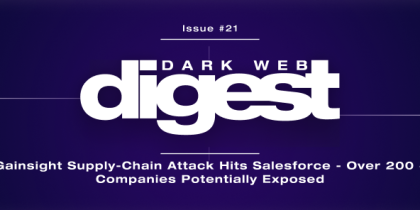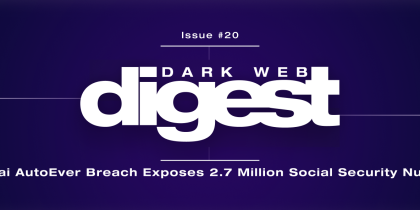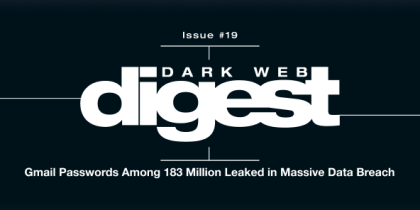Imagine waking up and realizing the cars you build — or drive — aren’t the only things at risk. Your name, your address, even internal files you thought were safe… all up for grabs on the dark web.
That’s the backdrop of the Jaguar Land Rover (JLR) attack: factories silent, supply chains stalled, and now, confirmation that data has indeed been stolen.
If you’re a JLR customer, supplier, or employee — or just someone who values their privacy — it’s time to treat metadata, internal logs, screenshots, and corporate data as prime targets. Because even without full confirmation, what might be on the dark web is enough to change everything.
This edition takes you inside how metadata became the hidden weapon, why hackers crave it on the dark web, who might be behind the breach, and how you can check if your own metadata is already at risk.
Your email could be compromised.
Scan it on the dark web for free – no signup required.
🧠What You Need to Know, Fast
- JLR confirms “some data has been affected” after the cyberattack starting 31 August 2025, though they haven’t spelled out exactly what data yet (customer, supplier, employee/or internal).
- Production & retail operations at JLR were halted globally (UK, India, China, Slovakia, Brazil), many workers were sent home, and systems were shut as a precaution.
- No public confirmation (yet) of customer personal data theft — but presence of “screenshots internal systems” posted online suggests possible metadata, configs, or internal documentation exposure.
- Regulators (like the UK ICO) have been notified; the forensic investigation is said to be “ongoing and at pace”.
- Estimated daily revenue losses due to the shutdown (factories offline, delays in dealerships, registrations) are likely significant, though precise cost figures haven’t been published publicly yet.
- You can scan your email address for free using PureVPN’s Dark Web Exposure Scan to see if it appears in any known breaches or leaks on the dark web. It works even if you’re not a user of PureVPN — so anyone can check if their critical personal identifiers are exposed.
⛓️ Who Is JLR & How Big Is This Hit
Jaguar Land Rover (JLR) is a major British luxury automaker (Jaguar & Land Rover brands), owned by Tata Motors. They produce hundreds of thousands of vehicles per year and sell globally.
Over 30,000 employees in the UK were sent home as factories like Solihull, Halewood, and Wolverhampton suspended operations.
The financial toll is large: estimated losses around £5 million (~USD $6.8 million) per day of shutdowns.
🔎Brief Background
Jaguar Land Rover announced on Friday that it is moving “at pace” to address a cyber incident that has caused major disruption across its retail operations and production lines. The automaker has asked factory employees to remain at home until at least early next week.
The incident, first disclosed on Tuesday, adds to a growing wave of cyber and ransomware attacks affecting companies worldwide. In the UK alone, well-known brands such as Marks & Spencer and Co-op have recently been hit by increasingly sophisticated breaches.

What Was Exposed?
According to multiple threat reports and dark web forum posts, the leak may include employee identifiers such as email addresses, usernames, display names, and metadata like time zones.
Some sources claim internal credentials (e.g., for Jira) were harvested via infostealer malware. However, Jaguar Land Rover has not yet confirmed exposure of employee email addresses or user IDs in the current breach; the claims remain unverified.
🕵️ Who’s Behind It?
Here are the leading suspects, claims, and analysis as of now in the Jaguar Land Rover breach:
A group calling itself “Scattered LAPSUS$ Hunters” has claimed responsibility. This name appears to combine or reference three known hacktivist/cybercrime collectives: Scattered Spider, Lapsus$, and ShinyHunters.
The hacker or user “Rey” is prominently involved in the claims. “Rey” has posted screenshots purporting to be from JLR’s internal systems over Telegram, boasting about the breach. Some reports link “Rey” to the Hellcat group from earlier JLR-related incidents.
What This Means (Dark Web Angle & User Risk)
Because there’s a public persona (Rey) making claims, there’s an opportunity for proof leaks (screenshots, internal docs) that may be posted or traded on Dark Web forums. Those proof pieces often include metadata, internal file paths, or logs — valuable for attackers.
The involvement of groups previously connected with data leaks/supply chain hacks increases the likelihood that exposed data is being monetized (sold), reused, or used for phishing/blackmail.
Users, suppliers, or employees connected to JLR should assume that their identities, credentials, or internal identifiers may be in scope of exposure — even if not yet confirmed — and act proactively.
What We Know (Confirmed) vs What’s Speculated
| ✅ Confirmed | 🔍 Speculated / Yet to Be Confirmed |
| Data was stolen (“some data has been affected”) in the attack. | What kind of data was leaked — customer, supplier, employee, or just internal? |
| The shutdowns of production and IT systems globally impacted retail, supply, and part registration. | If metadata like internal logs, parts codes, internal dashboards, or credentials were part of the leak. Evidence, such as screenshots, has appeared online. |
| Regulators informed (like ICO), and a forensic investigation is ongoing. | Dark web resale or sharing of the stolen data or internal proof pieces, whether credential reuse is possible. |
| Hackers claiming responsibility include a group dubbed “Scattered Lapsus$ Hunters” — possibly a hybrid of Scattered Spider, Lapsus$, and ShinyHunters. | Exact volume, scope, and whether personal customer PII is among the affected. |
💣 Why This Doesn’t Feel Like “Just a Factory Outage” — Dark Web Danger Mode Engaged
- Metadata & Screenshots are Proof, and Proof = Threat: Hackers posted screenshots purportedly from internal SAP/troubleshooting/internal logs. Even if they don’t have full datasets yet, screenshots act as credibility hooks — usable in phishing, social engineering, even blackmail.
- Supply Chain Amplification: JLR doesn’t operate alone. Disruption affects dealerships, spare parts suppliers, service departments — many of which might have weaker security. Exposed supplier emails, parts ordering systems, and internal portals could be next.
- Brand & Identity Fallout: Even rumors that customer data was not involved aren’t enough. In the age of dark web leaks, the whispers are the wildfire.
- Pre-Exposed Vulnerabilities Fuel Reuse: If employee credentials, internal dashboards, or supplier APIs were weakly protected (or reused), attackers can jump agents across systems. Reuse + metadata + proof = recipe for “credential shadow attacks.”
- Regulatory Risks = Dark Web Risks: Once regulators are involved (ICO, etc.), the scrutiny increases — transparency, fines, notification duties all force more data into the public eye. That amplifies how much metadata becomes weaponizable.
🛡️ Tactical Playbook — What You Should Do Right Now
Because waiting is what gives hackers the edge.
- Run PureVPN’s Dark Web Exposure Scan: Check for free if your email address and its related metadata are already available on the dark web. In less than 30 seconds, you’ll learn:
- If you are exposed
- How severe is the compromise
- How recent was the leak
- How many breaches include your account
- Freeze Reuse & Reset Access Points: If you use the same password or reuse login info across supplier portals, dealerships, or any JLR-linked service — change them. Also, enable MFA everywhere.
- Be Wary of “Insider-Sounding” Scams: Emails or calls referencing delayed vehicle registration, part orders, internal codes, or service tickets — especially ones referencing production shutdowns — could be phishing. Always verify via known channels.
- Monitor Your Data & Identity: Even if JLR says no customer data is confirmed as stolen, put fraud alerts on your identity, watch your credit, and check for account anomalies.
- Stay Updated & Demand Clarity: Companies will reveal more (or be forced to) — especially what data was taken. Don’t ignore updates; take action when details emerge.
What We Still Don’t Know: Big Questions That Could Spike Risk
Here is the list of questions that still need to be answered by JLR:
- Was any personal customer data (names, emails, addresses, payment info) taken?
- Did the breach include credentials (employee/supplier or system) or secrets (internal configuration, proprietary IP)?
- How long were systems compromised before detection?
- Are parts of the stolen data already circulating on dark web forums (proof pieces, screenshots)?
- What legal/regulatory charges or penalties JLR might face, depending on what data was stolen, plus how notification will roll out.
TL;DR — Why You Should Care
If you’re a JLR customer, supplier, or employee (or just someone who uses digital services), this is what matters:
- Screenshots = threat. Proof that data was touched.
- Metadata + internal info gives phishers context and legitimacy.
- Even if there is no confirmed customer data, it doesn’t equal “no risk” when internal operations and supplier chains are affected.
- Early detection tools (like Dark Web Exposure Scan) are your firewall of awareness: better to see the shadows before someone uses them against you.
🔮 What’s Next
Jaguar Land Rover has confirmed what many feared: this isn’t just a glitch in the system. Some data has been stolen in the cyberattack that began on 31 August, and global operations remain heavily disrupted — factories down, dealers delayed, staff sent home.
Here’s what’s likely coming, and why you should care:
- Extended Recovery & Ramp-Up
Restoring factory systems, reconnecting dealerships, parts supply, and internal IT — all of this is going to take weeks, possibly months, for full recovery. Some experts warn that downtime could persist for 9-12 months in terms of restoring security posture and trust. - Regulatory & Legal Fallout
Because JLR has admitted data theft (some data was “affected”) and has notified regulators such as the UK’s ICO, the company may face demands to disclose what categories of data were compromised. Depending on what emerges, there could be legal liability, fines, or class-action risk — especially if customer or employee personal information is confirmed stolen. - Proof Leaks & Dark Web Exposure
Even partial proof (screenshots, metadata from internal systems) is already showing up in public/hacker forums. Those act like breadcrumbs that often become full weaponization vectors (phishing templates, forged emails, identity theft). Expect hackers to test the waters: some leaks may get sold, reused, or embellished for more damage. - Heightened Phishing / Impersonation Risk
Given the nature of the disruption — dealers manually registering cars, parts delayed, customers waiting — attackers will exploit confusion. Look out for social engineering that references legitimate delays, internal codes, or production shutdowns as “proof” in scam messages. - Need for Clarity & Disclosure
JLR will need to clearly disclose what data was exposed (customer vs. employee vs. supplier vs. internal tools), how many were affected, and whether there are actionable risks. Transparency will matter hugely — for public trust, for regulatory compliance, and to reduce speculation (which fuels dark-web rumors).
📬 Why Subscribe?
Every week, we cut through the noise and bring you the breaches that matter, the tactics behind them, and the steps you need to protect yourself — all in a conversational, no-fluff format.
If you don’t want to be the last to know when your personal data hits the dark web, subscribing is your safety net.
👉 Stay ahead, stay secure, stay subscribed.
Note: This edition of Dark Web Digest is based on publicly available information as of Sept 15, 2025.








